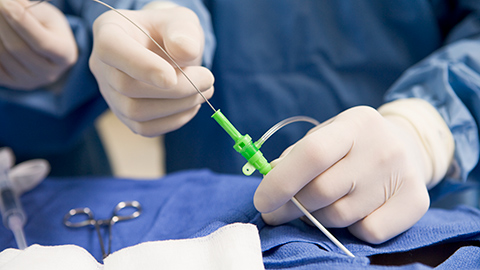11/18/2022

A client had a cardiac catheterization complication and had to be shocked back into a functional rhythm. Now he wants a massage, and his doctor seems to be on board. What is a cardiac catheterization, what does it mean to be shocked back into rhythm, and what does it mean for decisions about massage? In this episode of I Have a Client Who, Ruth explores this issue and answers these questions.
Resources:
Pocket Pathology: https://www.abmp.com/abmp-pocket-pathology-app
Cardiac Catheterization (2021). Available at: https://www.hopkinsmedicine.org/health/treatment-tests-and-therapies/cardiac-catheterization
Cardiac Catheterization | American Heart Association (no date). Available at: https://www.heart.org/en/health-topics/heart-attack/diagnosing-a-heart-attack/cardiac-catheterization
Contributors, W.E. (no date) Cardiac Catheterization, WebMD. Available at: https://www.webmd.com/heart-disease/cardiac-catheterization1 (Accessed: 16 November 2022).
Electrical Cardioversion | Johns Hopkins Medicine (no date). Available at: https://www.hopkinsmedicine.org/health/treatment-tests-and-therapies/electrical-cardioversion
Massage & Bodywork - NOVEMBER | DECEMBER 2020 (no date). Available at: http://www.massageandbodyworkdigital.com/i/1299745-november-december-2020/40?
What is Defibrillation Used For? (no date) Cleveland Clinic. Available at: https://my.clevelandclinic.org/health/treatments/23021-defibrillation


Books of Discovery: www.booksofdiscovery.com
Advanced-Trainings: www.advanced-trainings.com
About Til Luchau and Advanced-Trainings.com:
As a Certified Advanced Rolfer™, Til was on the faculty of the Dr. Ida Rolf Institute® for 20 years, where he served as Coordinator and Faculty Chair of the Foundations of Rolfing Structural Integration program. The author of the Advanced Myofascial Techniques textbook series (which has been translated into 6 languages), his regular Myofascial Techniques and Somatic Edge columns have been featured in Massage & Bodywork magazine since 2009, and (along with Whitney Lowe) he co-hosts the popular Thinking Practitioner Podcast. He is the Director of Advanced-Trainings.com which since 1985 has offered short, credit-approved professional trainings and certification for manual therapists of all types, in person and online.
Website: Advanced-Trainings.com
Email: info@advanced-trainings.com
Facebook: facebook.com/Advanced.Trainings1/
Instagram: instagram.com/tilluchau
YouTube: youtube.com/user/AdvancedTrainings
0:00:01.2 Ruth Werner: Hey, I Have a Client Who listeners. Did you know I have a growing library of NCB-approved one-hour online self-paced continuing education courses that you can do any time, anywhere. Well, now you know. Current classes include, What's Next COVID-19 Updates for Massage Therapists and A Massage Therapist's Introduction to Pharmacology part one, and brand new, A Massage Therapist's Introduction to Pharmacology part two. Classes are $20 each, and they confer one hour of continuing education credit. Wanna know more? Visit my website at ruthwerner.com and check it out. Be sure to sign up for my mailing list so you'll never miss a new class.
[music]
0:00:56.0 RW: Hi, and welcome to I Have a Client Who, Pathology Conversations with Ruth Werner, the podcast where I will discuss your real life stories about clients with conditions that are perplexing or confusing. I'm Ruth Werner, author of A Massage Therapist's Guide to Pathology, and I have spent decades studying, writing about and teaching about where massage therapy intersects with diseases and conditions that might limit our client's health. We almost always have something good to offer even with our most challenged clients, but we need to figure out a way to do that safely, effectively and within our scope of practice, and sometimes as we have all learned, that is harder than it looks.
0:01:42.4 RW: This week's episode is a double dose of cardiac challenge, an invasive procedure that leads to dysrhythmia and an emergency restart of the heart, and now this client hopes to get massage and the doctor says, Yeah, sure, go ahead. Oh, yikes. Really? The title of this episode is cardiac catheter complication, and had started with this. Did you ever do a podcast on heart catheterizations and getting the heart shocked back into rhythm? I had a regular who had this done, no stent needed, doctor said he could have a massage in a week, I was thinking longer to heal. Any information? Right. So the short answer is, we don't have enough information from this little bit of a story to make that call, but maybe after we consider the relevant variables, we can come up with at least a list of questions to help us get to a safe and effective clinical decision. We have two issues before us here, a heart catheterization and some kind of a shock to restart a healthy rhythm, and we will look just briefly at each of these, and then we will consider how to make some decisions about massage therapy.
0:02:57.4 RW: A cardiac catheterization or cardiac cath is a procedure in which a small tube is inserted from an artery into an extremity, the wrist in this case, but it could also be from the leg or other areas, and this goes up to the aorta and then two locations inside and around the heart. This tube can be guided into the heart chambers or various branches of the coronary arteries. It's really amazing when you think of it, because all of this can happen without opening up the body. A cardiac cath is not a treatment in itself, but it can be used to do a variety of things. This can be a delivery system for a balloon angioplasty, where a tiny balloon is inserted and inflated to widen sections of the coronary artery that have become occluded with plaque or a cardiac cath could be a carrier for a stent that is inserted to keep a section of coronary artery widened. It can deliver contrast medium so that images of the arteries can be taken and it can carry measurement tools to check the pressure inside the walls of the heart chambers.
0:04:08.3 RW: However, getting a cardiac cath is not a simple low risk intervention. The list of possible adverse events is substantial, and it includes these things. This is all from the Johns Hopkins page on cardiac catheterization. They list bleeding or bruising where the catheter is put into the body, which is the groin, the arm, the neck, or the wrist. Also, pain where the catheter is put into the body, a blood clot or damage to blood vessels, where the catheter is put in, infection where the catheter is put in or related to damaged internal tissue, problems with heart rhythm, and then more serious but rarer complications include ischemia, chest pain or heart attack, sudden blockage of a coronary artery, a tear in the lining of an artery, kidney damage from the dye used if they're using a contrast medium and oh, yeah, stroke.
0:05:06.2 RW: So I know from our contributor that this client's experience with heart catheterization and then getting their heart shocked back into a rhythm, all happened at the same event. So it sounds like he had a problem with his heart rhythm during or right after this catheterization procedure. For the sake of being thorough, I looked into getting shocked back into rhythm and not surprisingly, it's more complicated than it sounds. There are two types of procedures here, defibrillation, which is most often used in life-threatening situations, and synchronized cardioversion, which is much more refined, it deals with a specific moment in the heart rhythm, and it usually has a very short recovery time. When it is proper to use which kind of procedure is, I am so very happy to say not our call, and frankly, it doesn't make a huge difference for judgments about massage therapy outside of recovery time, but it may reveal something about this client's underlying heart issues again, these are largely shades of subtlety.
0:06:13.9 RW: So with this history and no other information, we just don't know if this person's dysrhythmia was related to his procedure, or from a heart attack or a sepsis or a stroke or something entirely different. It's great that his cardiologist thinks massage is okay after only a week's recovery but you know my opinion about that, it's not the doctor's call to establish whether our work is safe and our contributor is right to be cautious about rushing back to massage as usual. So what do we need to know first? Well, here are a few things. Why did this person need a catheterization? What other cardiovascular or other health issues does he have? What body work precautions are needed for the site at the catheter insertion? What medications does he take? What are his goals for massage and above all, what is his general level of activity? Can he keep up with the changes that massage might bring about?
0:07:18.3 RW: Without some of this key information, it's hard to say that any body work other than the most gentle soothing touch is in this person's best interest, but maybe he could benefit from massage that's more directed than that if we can get the right information. And guess what? We do have some of that information. I got very lucky with this contributor who was able to fill in some more of our background for this client, who frankly sounds like an absolutely delightful person. Here's what I learned. He's 82, but acts like 64. He's hard-working all the time. He has back problems and gets weekly massages. He talked to his cardiologist and got an okay to get massage this week on his back, no arm work though. The catheter went in through the wrist. There was no blockage, no stent needed, and now he has medication to help with AFib. He's also been a client for 18 years. He's a retired mechanic, still tinkering with motors. He volunteers at keeping the grounds up with mowing and trimming trees at his fish and game club. He uses an inversion table for his back pain. He takes blood pressure medicine, and now blood thinners.
0:08:29.9 RW: Well, this fills in a lot of blanks. We know that he's an older man, but it sounds like he's physically active with all his volunteer work, mowing and trimming trees and so on. He's a well-known client, they've been working together weekly for 18 years to help with his back pain, and he has AFib, that's atrial fibrillation, and that is a whole topic in itself. For now, let's just understand that it means that sometimes his atria don't contract in a normal way, they flutter instead of contracting, and this can lead to blood clots inside of the chambers of the heart, and then an increased risk for stroke, and heart attack, pulmonary embolism and other infections. I wrote an article on cardiac arrhythmias that appears in the November, December 2020 edition of massage and body work. And of course, I'll put a link to that in the show notes in case you'd like more background on AFib and related problems.
0:09:28.9 RW: This issue does raise a couple of questions for me. For instance, was his AFib known ahead of time or did the cardiac cath discover it? This is not the way AFib is typically diagnosed, by the way, and I was able to follow up with our contributor who confirmed that the AFib had been identified ahead of time. This client is using medicine to manage high blood pressure and clotting risks. That makes sense, especially with the AFib issue. However, I'm curious if the blood thinner is a new prescription. The way our contributor described it, it sounds like it could be, and I'll say more about that in a bit. His catheter procedure shows that he has no blockage, at least in the coronary arteries that they explored, so he didn't need a stent. That's good news, of course. And because that was the finding that he shared, I will infer that that was the purpose of this catheterization, but actually we don't really know what he went in for that procedure. And when he asked his cardiologist about massage, the go-ahead was for massage on his back and specifically not to the arm where his catheter was inserted.
0:10:37.1 RW: All of this is terrific information, and one of my favorite things about human anatomy is that, well, many of us really crave massage for the back, the upper back, the lower back, and anywhere in between. This is not an area where we have a bunch of endangerment sites related to blood vessels, it's one of the safest areas of the body where we can receive even deep and specific touch. Woohoo.
0:11:04.3 RW: I still have three main questions or concerns at this point. Firstly, I really appreciate this practitioner's caution, and I suggest delaying any deeply intense massage until this client is more or less back to pre-catheter levels of activity. Also, I wonder whether this client would be comfortable lying prone on a massage table or if any residual discomfort from his procedure might be a problem. And lastly, of course, this practitioner needs to make appropriate accommodations for the client's medications and any side effects they might cause. If the blood thinner is new for him and it sounds like it might be, then there might be a period of adjustment while I find just the right prescription and dose, because they don't always get it perfect on the first try. Given that this client has been through a lot recently, I imagine he must be eager to get back on the massage table to help with his back pain and with some adjustments for his general levels of energy and activity that is definitely in the cards for him. I'm so glad he has come under the care of this cautious and careful massage therapist, and I'm so glad that you have joined us for this short exploration of cardiac catheters and possible complications.
0:12:24.6 RW: Hey everybody, thanks for listening to, I Have a Client Who, Pathology Conversations with Ruth Werner. Remember, you can send me your I Have a Client Who stories to ihaveaclientwho@abmp.com. That's, I have a client who, all one word, all lowercase at abmp.com. I can't wait to see what you send me and I'll see you next time.
[music]





